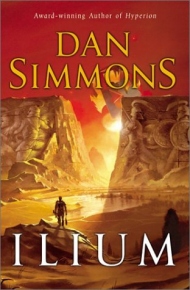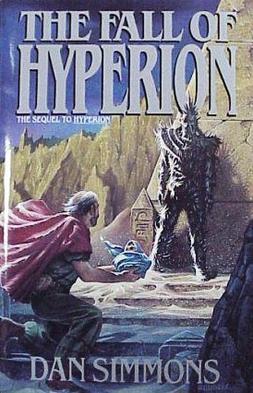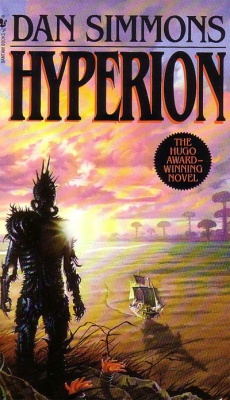An ansible is a category of fictional devices or technology capable of near-instantaneous or faster-than-light communication. It can send and receive messages to and from a corresponding device over any distance or obstacle whatsoever with no delay, even between star systems. As a name for such a device, the word "ansible" first appeared in a 1966 novel by Ursula K. Le Guin. Since that time, the term has been broadly used in the works of numerous science fiction authors, across a variety of settings and continuities. A related term is ultrawave.
Dan Simmons is an American science fiction and horror writer. He is the author of the Hyperion Cantos and the Ilium/Olympos cycles, among other works which span the science fiction, horror, and fantasy genres, sometimes within a single novel. Simmons's genre-intermingling Song of Kali (1985) won the World Fantasy Award. He also writes mysteries and thrillers, some of which feature the continuing character Joe Kurtz.
Known Space is the fictional setting of about a dozen science fiction novels and several collections of short stories by American writer Larry Niven. It has also become a shared universe in the spin-off Man-Kzin Wars anthologies. The Internet Speculative Fiction Database (ISFDB) catalogs all works set in the fictional universe that includes Known Space under the series name Tales of Known Space, which was the title of a 1975 collection of Niven's short stories. The first-published work in the series, which was Niven's first published piece, was "The Coldest Place", in the December 1964 issue of If magazine, edited by Frederik Pohl. This was the first-published work in the 1975 collection.
Endymion primarily refers to:

Ilium is a science fiction novel by American writer Dan Simmons, the first part of the Ilium/Olympos cycle, concerning the re-creation of the events in the Iliad on an alternate Earth and Mars. These events are set in motion by beings who have taken on the roles of the Greek gods. Like Simmons' earlier series, the Hyperion Cantos, the novel is a form of "literary science fiction" which relies heavily on intertextuality, in this case with Homer and Shakespeare, as well as periodic references to Marcel Proust's À la recherche du temps perdu and Vladimir Nabokov's novel Ada or Ardor: A Family Chronicle. In July 2004, Ilium received a Locus Award for Best Science Fiction Novel of 2004.

The Fall of Hyperion is the second novel in the Hyperion Cantos, a science fiction series by American author Dan Simmons. The novel, written in 1990, won both the 1991 British Science Fiction and Locus Awards. It was also nominated for the Hugo Award and the Nebula Award.
A shrike is a passerine bird of the family Laniidae.

Hyperion is a 1989 science fiction novel by American author Dan Simmons. The first book of his Hyperion Cantos series, it won the Hugo Award for best novel.

Endymion is a poem by John Keats first published in 1818 by Taylor and Hessey of Fleet Street in London. John Keats dedicated this poem to the late poet Thomas Chatterton. The poem begins with the line "A thing of beauty is a joy for ever". Endymion is written in rhyming couplets in iambic pentameter. Keats based the poem on the Greek myth of Endymion, the shepherd beloved of the moon goddess Selene. The poem elaborates on the original story and renames Selene "Cynthia".

A Dyson tree is a hypothetical genetically engineered plant capable of growing inside a comet, suggested by the physicist Freeman Dyson. Plants may be able to produce a breathable atmosphere within the hollow spaces of the comet, utilising solar energy for photosynthesis and cometary materials for nutrients, thus providing self-sustaining habitats for humanity in the outer solar system analogous to a greenhouse in space, a shell grown by a mollusc or the actions of thermogenic plants, such as the skunk cabbage or the voodoo lily.
This is a list of occurrences of space elevators in fiction. Some depictions were made before the space elevator concept became fully established.
The Alliance–Union universe is a fictional universe created by American writer C. J. Cherryh. It is the setting for a future history series extending from the 21st century into the far future.

Far Horizons: All New Tales from the Greatest Worlds of Science Fiction is an anthology of original science fiction stories edited by Robert Silverberg, first published in hardcover by Avon Eos in May 1999, with a book club edition following from Avon and the Science Fiction Book Club in July of the same year. Paperback and trade paperback editions were issued by Eos/HarperCollins in May 2000 and December 2005, respectively, and an ebook edition by HarperCollins e-books in March 2009. The first British edition was issued in hardcover and trade paperback by Orbit/Little Brown in June 1999, with a paperback edition following from Orbit in July 2000.
"Orphans of the Helix" is a 46-page science fiction short story by American writer Dan Simmons, set in his Hyperion Cantos fictional universe. It was first published in the anthology Far Horizons in 1999.

Prayers to Broken Stones is a short story collection by American author Dan Simmons. It includes 13 of his earlier works, along with an introduction by Harlan Ellison in which the latter relates how he "discovered" Dan Simmons at the Colorado Mountain College's "Writers' Conference in the Rockies" in 1981. The title is a borrowed line from T. S. Eliot's "The Hollow Men".
Pantropy is a hypothetical process of space habitation or space colonization in which, rather than terraforming other planets or building space habitats suitable for human habitation, humans are modified to be able to thrive in the existing environment. The term was coined by science fiction author James Blish, who wrote a series of short stories based on the idea.

Endymion is the third science fiction novel by American writer Dan Simmons, first published in 1996. Part of his Hyperion Cantos fictional universe, it centers on the new characters Aenea and Raul Endymion, and was well received, like its predecessors Hyperion and The Fall of Hyperion. Within a year of its release, the paperback edition had gone through five reprints. The novel was shortlisted for the 1997 Locus Award.
Ilium/Olympos is a series of two science fiction novels by Dan Simmons. The events are set in motion by beings who appear to be ancient Greek gods. Like Simmons' earlier series, the Hyperion Cantos, it is a form of "literary science fiction"; it relies heavily on intertextuality, in this case with Homer and Shakespeare as well as references to Marcel Proust's À la recherche du temps perdu and Vladimir Nabokov's novel Ada or Ardor: A Family Chronicle.

The Rise of Endymion is a 1997 science fiction novel by American writer Dan Simmons. It is the fourth and final novel in his Hyperion Cantos fictional universe. It won the Locus Award for Best Science Fiction Novel, and was nominated for the Hugo Award for Best Novel in 1998.









